Geography of Kenya
The geography of Kenya is diverse, varying amongst Kenya's 47 Counties. Kenya has a coastline on the Indian Ocean, which contains swamps of East African mangroves. Inland are broad plains and numerous hills. Kenya borders South Sudan to the northwest, Uganda to the west, the Jubaland province of Somalia to the east, Tanzania to the south, and Ethiopia to the north.
 | |
| Continent | Africa |
|---|---|
| Region | East Africa |
| Coordinates | 1°00′N 38°00′E |
| Area | Ranked 48th |
| • Total | 580,367 km2 (224,081 sq mi) |
| • Land | 98.07% |
| • Water | 1.93% |
| Coastline | 536 km (333 mi) |
| Borders | 3,446 km (2,141 mi) |
| Highest point | Mount Kenya 5,197 metres (17,051 ft) |
| Lowest point | Indian Ocean 0 metres (0 ft) |
| Longest river | Tana River (Kenya) (wholly within Kenya) 800 km (500 mi) |
| Largest lake | Lake Turkana 6,405 km2 (2,473 sq mi) |
| Exclusive economic zone | 116,942 km2 (45,152 sq mi) |
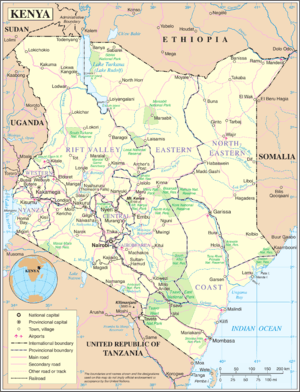

Central and Western Kenya is characterised by the Kenyan Rift Valley and central province home to the highest mountain, Mount Kenya and Mount Elgon on the border between Kenya and Uganda. The Kakamega Forest in western Kenya is a relic of an East African rainforest. Much bigger is Mau Forest, the largest forest complex in East Africa.
Geography
Location
- Eastern Africa on the Indian Ocean coast between the Jubaland province of Somalia and Tanzania
- Geographic coordinates: 1°00′N 38°00′E
Area
- Total: 582,650 km2 (224,960 sq mi)
- Land: 569,140 km2 (219,750 sq mi)
- Water: 11,227 km2 (4,335 sq mi)
Coastline
- 536 km (333 mi) along the Indian Ocean.
Maritime claims
- Territorial sea: 12 nmi (22.2 km; 13.8 mi)
- Exclusive economic zone: 116,942 km2 (45,152 sq mi) and 200 nmi (370.4 km; 230.2 mi)
- Continental shelf: 200 m depth or to the depth of exploitation
Geology
Much of the western two-thirds of the country consists of the Pliocene–Pleistocene volcanics deposited on Precambrian basement rocks.[2] The southeast corner of the country is underlain by sediments of the Karoo System of Permian to Late Triassic age and a strip of Jurassic age sediments along the coast in the Mombasa area.[2] The Anza trough is a NW–SE trending Jurassic rift extending from the Indian Ocean coast to the Sudan northwest of Lake Turkana. The Anza Rift resulted from the break–up of Gondwana.[2][3]
Climate
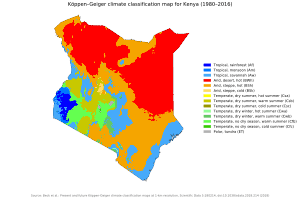
The climate of Kenya varies by location, from mostly cool every day, to always warm/hot.[4][5][6] The climate along the coast is tropical. This means rainfall and temperatures are higher throughout the year. At the coastal cities, Mombasa, Lamu and Malindi, the air changes from cool to hot, almost every day. (See chart below).[6]
The further inside Kenya, the more arid the climate becomes. An arid climate is nearly devoid of rainfall, and temperature swings widely according to the general time of the day/night. For many areas of Kenya, the daytime temperature rises about 12 °C (corresponding to a rise of about 22 °F), almost every day.[4][5][6]
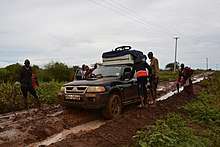
Elevation is the major factor in temperature levels, with the higher areas, on average, as 11 °C (20 °F) cooler, day or night.[4][5][6] The many cities over a kilometre in elevation have temperature swings from roughly 10–26 °C (50–79 °F). Nairobi, at 1,798 m (5,899 ft), ranges from 9–27 °C (49–80 °F),[4] and Kitale, at 1,825 m (5,988 ft), ranges from 11–28 °C (51–82 °F).[5] At night, heavy clothes or blankets are needed, in the highlands, when the temperature drops to about 10–12 °C (50–54 °F) every night.
At lower altitudes, the increased temperature is like day and night, literally: like starting the morning at the highland daytime high, and then adding the heat of the day, again. Hence, the overnight low temperatures near sea level are nearly the same as the high temperatures of the elevated Kenyan highlands. However, locations along the Indian Ocean have more moderate temperatures, as a few degrees cooler in the daytime, such as at Mombasa (see chart below).
There are slight seasonal variations in temperature, of 4 °C or 7.2 °F,[4][5][6] cooler in the winter months. Although Kenya is centred at the equator, it shares the seasons of the southern hemisphere: with the warmest summer months in December–March and the coolest winter months in June–August, again with differences in temperature varying by location within the country.[4][5][6]
On the high mountains, such as Mount Kenya, Mount Elgon and Kilimanjaro, the weather can become bitterly cold for most of the year. Some snowfall occurs on the highest mountains.
| Climate data for Mombasa (at Indian Ocean)[6] | |||||||||||||||
|---|---|---|---|---|---|---|---|---|---|---|---|---|---|---|---|
| NOAA Code | Statistic | Jan | Feb | Mar | Apr | May | Jun | Jul | Aug | Sep | Oct | Nov | Dec | Avg | |
| 0101 | Temperature Average F | 81.7 | 82.6 | 82.9 | 81.7 | 79.2 | 76.6 | 75.2 | 75.2 | 76.5 | 78.3 | 80.4 | 81.3 | 79.3 | |
| 0201 | Temperature High value F | 91.8 | 92.7 | 92.7 | 90.5 | 87.6 | 84.9 | 83.7 | 83.8 | 85.5 | 86.9 | 88.9 | 91 | 88.3 | |
| 0301 | Temperature Low value F | 71.6 | 72.5 | 73.2 | 72.9 | 70.9 | 68.2 | 66.7 | 66.7 | 67.5 | 69.6 | 71.8 | 71.6 | 70.3 | |
| 0615 | Precipitation in inches[6] | 1.4 | 0.6 | 2.3 | 6.3 | 9.7 | 3.6 | 2.9 | 2.8 | 2.8 | 4.2 | 4.3 | 3.1 | 3.7 | |
| 0101 | Temperature Average C | 27.6 | 28.1 | 28.3 | 27.6 | 26.2 | 24.8 | 24.0 | 24.0 | 24.7 | 25.7 | 26.9 | 27.4 | 26.27 | |
| 0201 | Temperature High value C | 33.2 | 33.7 | 33.7 | 32.5 | 30.9 | 29.4 | 28.7 | 28.8 | 29.7 | 30.5 | 31.6 | 32.8 | 31.29 | |
| 0301 | Temperature Low value C | 22.0 | 22.5 | 22.9 | 22.7 | 21.6 | 20.1 | 19.3 | 19.3 | 19.7 | 20.9 | 22.1 | 22.0 | 21.26 | |
| 0615 | Precipitation in mm[6] | 33.9 | 14.0 | 55.6 | 154.3 | 246 | 88.3 | 71.8 | 68.2 | 67.2 | 103.4 | 104.7 | 75.8 | 89.39 | |
| 1109 | Humidity Maximum % | 76.0 | 76.0 | 78.0 | 82.0 | 85.0 | 84.0 | 86.0 | 85.0 | 82.0 | 81.0 | 80.0 | 78.0 | 81.08 | |
| 1110 | Humidity[6] Minimum % | 62.0 | 59.0 | 61.0 | 66.0 | 70.0 | 67.0 | 67.0 | 66.0 | 65.0 | 66.0 | 68.0 | 65.0 | 65.17 | |
Terrain
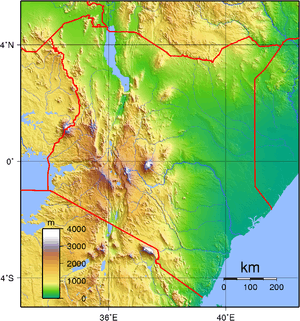
Kenya's terrain is composed of low plains that rise into central highlands that are, in turn, bisected by the Great Rift Valley. There is also a fertile plateau in the west of the country.
Elevation extremes
The lowest point on Kenya is at sea level on the Indian Ocean. The highest point on Kenya is 5,197 meters above sea level at Mount Kenya.
Rivers
The three main rivers are the Galana and the Tana and The Nzoia River which is a 257-kilometre-long (160 mi) Kenyan river, rising from Mount Elgon. It flows south and then west, eventually flowing into Lake Victoria near the town of Port Victoria. However, the Ewaso Ng'iro is an important river, supplying water from Mt. Kenya to the eastern and north-eastern part of Kenya.
Natural resources
Natural resources that are found in Kenya include: limestone, soda ash, salt, gemstones, fluorspar, zinc, diatomite, oil, gas, gypsum, wildlife and hydropower.
Land use
9.8% of the land is arable; permanent crops occupy 0.9% of the land, permanent pasture occupy 37.4% of the land; forest occupies 6.1% of the land. Other uses make up the rest of Kenya's land. This is as of 2011.
1,032 km2 of Kenyan land was irrigated in 2003.
Total renewable water resources
30.7 km3 (2011)
Freshwater withdrawal
- Total: 2.74 km3/yr (17%/4%/79%)
- Per capita: 72.96 m3/yr (2003)
Gallery
- Thompson (4955 m), Batian (5199 m) and Nelion (5188 m) on Mt Kenya
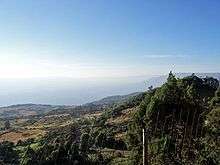 The Great Rift Valley as it is visible near Eldoret, Kenya
The Great Rift Valley as it is visible near Eldoret, Kenya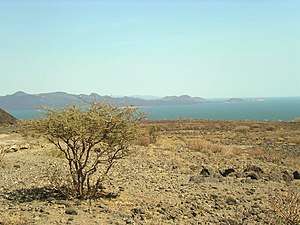
- The Fourteen Falls near Thika
Natural hazards
Natural hazards include recurring drought and flooding during the rainy seasons.
There is limited volcanic activity in the country. Barrier Volcano (elev. 1,032 m) last erupted in 1921. Several others have been historically active (see List of volcanoes in Kenya).
Environmental issues
Current issues
Current issues that threaten the environment at the moment include water pollution from urban and industrial wastes; degradation of water quality from the increased use of pesticides and fertilisers; deforestation; water hyacinth infestation in Lake Victoria; soil erosion; desertification; and poaching.
International agreements
- Party to: Biodiversity, Climate Change, Climate Change-Kyoto Protocol, Desertification, Endangered Species, Hazardous Wastes, Law of the Sea, Marine Dumping, Marine Life Conservation, Ozone Layer Protection, Ship Pollution (MARPOL 73/78), Wetlands, Whaling.
Extreme points
This is a list of the extreme points of Kenya, the points that are further north, south, east or west than any other location.
- Northernmost point – Kalukwakerith Mountain, Turkana County
- Easternmost point – the tripoint with Ethiopia and Somalia, Mandera County
- Southernmost point – the point where the border with Tanzania enters the Indian Ocean, Kwale County
- Westernmost point – unnamed land west of Port Victoria, Busia County
- Note: Kalukwakerith Mountain is in the disputed Ilemi Triangle region. If this area is excluded then Kenya does not have a northernmost point, the northern border being a straight line.
See also
References
- cia.gov – The World Factbook Kenya
- Petroleum Potential of NW-Kenya Rift Basins: A Synopsis of Evidence and Issues
- L C Greene; D R Richards; R A Johnson (1991). "Crustal structure and tectonic evolution of the Anza rift, northern Kenya". Tectonophysics. 197 (2–4): 203–211. doi:10.1016/0040-1951(91)90041-P. Retrieved 20 November 2011.
- "NairobiDagoretti, Kenya: Climate, Global Warming, and Daylight Charts and Data", Climate-Charts.com, 2008, web: CC741 Archived 29 July 2013 at the Wayback Machine: compare Nairobi/Dagoretti data with or Mombasa charts.
- "Kitale, Kenya: Climate, Global Warming, and Daylight Charts and Data", Climate-Charts.com, 2008, web: CC661 Archived 29 July 2013 at the Wayback Machine.
- "Mombasa, Kenya: Climate, Global Warming, and Daylight Charts and Data", Climate-Charts.com, 2008, web: CC820 Archived 1 November 2014 at the Wayback Machine: May precipitation was reset as "246" mm, converting 9.7 in.
.svg.png)